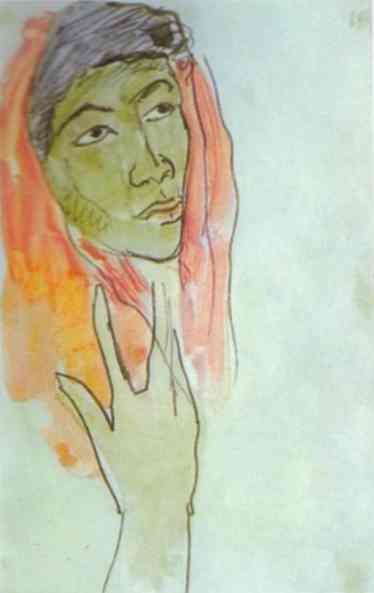描述
Paul Gauguin's painting "Head of a Woman", created in 1892, is a work that encapsulates the artist's quest to explore beauty through simplification and emotionality in the depiction of the female figure. In this work, Gauguin uses his signature post-impressionist style, which moves away from the conventions of realism and detailed precision that dominated the art of his time.
Looking at the composition of this painting, we find a portrait that highlights the head of a woman, whose enigmatic expression evokes a sense of introspection. The structure of the work is notable for its focus on the face, which is centralized and occupies most of the canvas. This treatment reveals Gauguin's interest in the psychological and emotional traits of his subjects, as opposed to a mere physical portrait. The woman, whose skin is a warm brown tone, suggests a connection with indigenous cultures, as at this period in his life, Gauguin had moved to Tahiti, where Polynesian culture deeply influenced his work.
Colour is a key element in this painting. Gauguin employs a bold, saturated palette consisting of earthy tones, contrasted with crisp blues and greens that possibly allude to vegetation or the natural environment. This colour choice not only serves to highlight the woman’s figure, but also contributes to an atmosphere of tranquillity and contemplation. The black outlines that mark the eyes and mouth make a strong visual impression and add a degree of emotional intensity to the portrait, imbuing it with an inherent life that seems to resonate with the viewer.
As for the representation of the female figure in Gauguin's art, it should be mentioned that the artist frequently explored the duality of sensuality and spirituality. The woman depicted in "Head of a Woman" seems to evoke this tension; her gaze, fixed but distant, suggests both a visual connection and an emotional detachment. This portrait can be seen as a reflection of the complexities of the female soul, as well as the artist's vision of femininity in the context of his time.
It should be noted that "Head of a Woman" forms part of a larger corpus of female portraits by Gauguin, where he often draws inspiration from sitters from his life in Polynesia and his idealization of indigenous culture. His style has radically influenced the development of modern art, opening up new avenues for meaningful and emotional expression within portraiture, freeing it from the narrative styles of the past.
In conclusion, “Head of a Woman” is not only a masterpiece of post-impressionism but also a mirror that reflects Paul Gauguin’s aesthetic and philosophical concerns. Through the foray into the psychology of portraiture, the bold use of color, and the exploration of the female figure, Gauguin establishes himself not only as an artist of his time, but as an innovator in the visual narrative of Western art. The work continues to resonate with contemporary audiences, highlighting not only the artist’s technical prowess, but also his ability to evoke emotion and contemplation through the simplicity of a head, which is much more than a mere portrait, it is a journey into the depths of the human being.
KUADROS ©, a famous painting on your wall.
Hand-made oil painting reproductions, with the quality of professional artists and the distinctive seal of KUADROS ©.
Painting reproduction service with satisfaction guarantee. If you are not completely satisfied with the replica of your painting, we will refund 100% of your money.

